Related Research Articles

Greenland is located between the Arctic Ocean and the North Atlantic Ocean, northeast of Canada and northwest of Iceland. The territory comprises the island of Greenland—the largest island in the world—and more than a hundred other smaller islands. Greenland has a 1.2 kilometre long border with Canada on Hans Island. A sparse population is confined to small settlements along certain sectors of the coast. Greenland possesses the world's second-largest ice sheet.
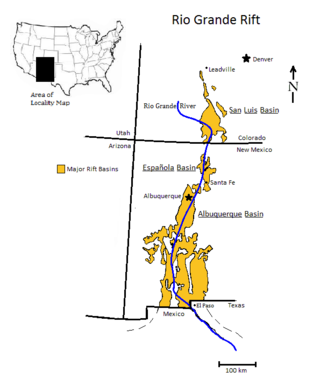
The Rio Grande rift is a north-trending continental rift zone. It separates the Colorado Plateau in the west from the interior of the North American craton on the east. The rift extends from central Colorado in the north to the state of Chihuahua, Mexico, in the south. The rift zone consists of four basins that have an average width of 50 kilometres (31 mi). The rift can be observed on location at Rio Grande National Forest, White Sands National Park, Santa Fe National Forest, and Cibola National Forest, among other locations.

The Labrador Sea is an arm of the North Atlantic Ocean between the Labrador Peninsula and Greenland. The sea is flanked by continental shelves to the southwest, northwest, and northeast. It connects to the north with Baffin Bay through the Davis Strait. It is a marginal sea of the Atlantic.

Arctica, or Arctida was an ancient continent which formed approximately 2.565 billion years ago in the Neoarchean era. It was made of Archaean cratons, including the Siberian Craton, with its Anabar/Aldan shields in Siberia, and the Slave, Wyoming, Superior, and North Atlantic cratons in North America. Arctica was named by Rogers 1996 because the Arctic Ocean formed by the separation of the North American and Siberian cratons. Russian geologists writing in English call the continent "Arctida" since it was given that name in 1987, alternatively the Hyperborean craton, in reference to the hyperboreans in Greek mythology.
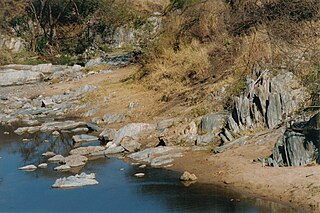
Greenstone belts are zones of variably metamorphosed mafic to ultramafic volcanic sequences with associated sedimentary rocks that occur within Archaean and Proterozoic cratons between granite and gneiss bodies.

A mid-ocean ridge (MOR) is a seafloor mountain system formed by plate tectonics. It typically has a depth of about 2,600 meters (8,500 ft) and rises about 2,000 meters (6,600 ft) above the deepest portion of an ocean basin. This feature is where seafloor spreading takes place along a divergent plate boundary. The rate of seafloor spreading determines the morphology of the crest of the mid-ocean ridge and its width in an ocean basin.
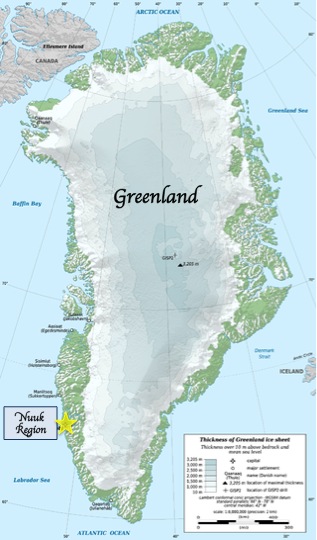
The Isua Greenstone Belt is an Archean greenstone belt in southwestern Greenland, aged between 3.7 and 3.8 billion years. The belt contains variably metamorphosed mafic volcanic and sedimentary rocks, and is the largest exposure of Eoarchaean supracrustal rocks on Earth. Due to its age and low metamorphic grade relative to many Eoarchaean rocks, the Isua Greenstone Belt has become a focus for investigations on the emergence of life and the style of tectonics that operated on the early Earth.

The geology of Iceland is unique and of particular interest to geologists. Iceland lies on the divergent boundary between the Eurasian plate and the North American plate. It also lies above a hotspot, the Iceland plume. The plume is believed to have caused the formation of Iceland itself, the island first appearing over the ocean surface about 16 to 18 million years ago. The result is an island characterized by repeated volcanism and geothermal phenomena such as geysers.
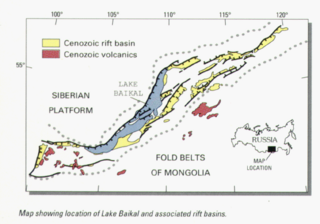
The Baikal Rift Zone is a series of continental rifts centered beneath Lake Baikal in southeastern Russia. Current strain in the rifts tends to be extending with some shear movement. A series of basins form along the zone for more than 2,000 kilometres (1,200 mi), creating a rift valley. The rifts form between the Eurasian Plate to the west and the Amur Plate to the east.
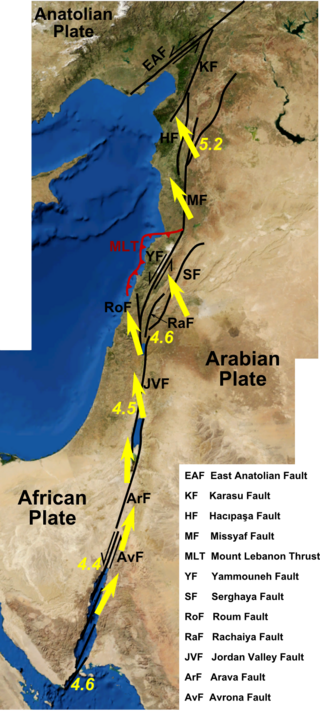
The Dead Sea Transform (DST) fault system, also sometimes referred to as the Dead Sea Rift, is a series of faults that run for about 1,000 km from the Maras Triple Junction to the northern end of the Red Sea Rift. The fault system forms the transform boundary between the African Plate to the west and the Arabian Plate to the east. It is a zone of left lateral (sinistral) displacement, signifying the relative motions of the two plates. Both plates are moving in a general north-northeast direction, but the Arabian Plate is moving faster, resulting in the observed left lateral motions along the fault of approximately 107 km at its southern end. A component of extension is also present in the southern part of the transform, which has contributed to a series of depressions, or pull-apart basins, forming the Gulf of Aqaba, Dead Sea, Sea of Galilee, and Hula basins. A component of shortening affects the Lebanon restraining bend, leading to uplift on both sides of the Beqaa valley. There is local transtension in the northernmost part of the fault system, forming the Ghab pull-apart basin. The fault system runs roughly along the political border of Israel, Jordan, and Lebanon.

The North Atlantic Igneous Province (NAIP) is a large igneous province in the North Atlantic, centered on Iceland. In the Paleogene, the province formed the Thulean Plateau, a large basaltic lava plain, which extended over at least 1.3 million km2 (500 thousand sq mi) in area and 6.6 million km3 (1.6 million cu mi) in volume. The plateau was broken up during the opening of the North Atlantic Ocean leaving remnants preserved in north Ireland, west Scotland, the Faroe Islands, northwest Iceland, east Greenland, western Norway and many of the islands located in the north eastern portion of the North Atlantic Ocean. The igneous province is the origin of the Giant's Causeway and Fingal's Cave. The province is also known as Brito–Arctic province and the portion of the province in the British Isles is also called the British Tertiary Volcanic Province or British Tertiary Igneous Province.
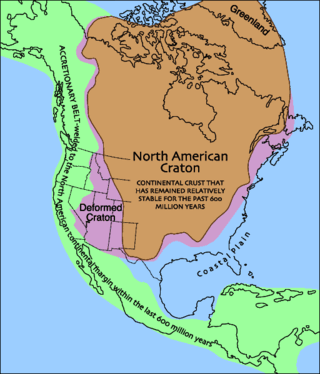
Laurentia or the North American Craton is a large continental craton that forms the ancient geological core of North America. Many times in its past, Laurentia has been a separate continent, as it is now in the form of North America, although originally it also included the cratonic areas of Greenland and also the northwestern part of Scotland, known as the Hebridean Terrane. During other times in its past, Laurentia has been part of larger continents and supercontinents and itself consists of many smaller terranes assembled on a network of Early Proterozoic orogenic belts. Small microcontinents and oceanic islands collided with and sutured onto the ever-growing Laurentia, and together formed the stable Precambrian craton seen today.

The Aegean Sea Plate is a small tectonic plate located in the eastern Mediterranean Sea under southern Greece and western Turkey. Its southern edge is the Hellenic subduction zone south of Crete, where the African Plate is being swept under the Aegean Sea Plate. Its northern margin is a divergent boundary with the Eurasian Plate.
This is a list of articles related to plate tectonics and tectonic plates.

The East Antarctic Shield or Craton is a cratonic rock body that covers 10.2 million square kilometers or roughly 73% of the continent of Antarctica. The shield is almost entirely buried by the East Antarctic Ice Sheet that has an average thickness of 2200 meters but reaches up to 4700 meters in some locations. East Antarctica is separated from West Antarctica by the 100–300 kilometer wide Transantarctic Mountains, which span nearly 3,500 kilometers from the Weddell Sea to the Ross Sea. The East Antarctic Shield is then divided into an extensive central craton that occupies most of the continental interior and various other marginal cratons that are exposed along the coast.

Eoarchean geology is the study of the oldest preserved crustal fragments of Earth during the Eoarchean era from 4.031 to 3.6 billion years ago. Major well-preserved rock units dated Eoarchean are known from three localities, the Isua Greenstone Belt in Southwest Greenland, the Acasta Gneiss in the Slave Craton in Canada, and the Nuvvuagittuq Greenstone Belt in the eastern coast of Hudson Bay in Quebec. From the dating of rocks in these three regions scientists suggest that plate tectonics could go back as early as Eoarchean.
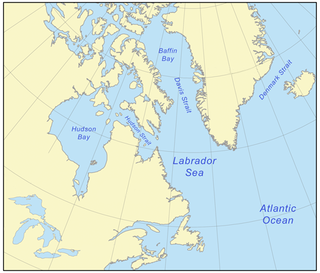
The Canadian Arctic Rift System is a major North American geological structure extending from the Labrador Sea in the southeast through Davis Strait, Baffin Bay and the Arctic Archipelago in the northwest. It consists of a series of interconnected rifts that formed during the Paleozoic, Mesozoic and Cenozoic eras. Extensional stresses along the entire length of the rift system have resulted in a variety of tectonic features, including grabens, half-grabens, basins and faults.
The Akia terrane is a tectonostratigraphic terrane located in the North Atlantic Craton in southern West Greenland. The Akia terrane is bounded to the Southeast by the Eo- to Neo-archaean tectonostratigraphic terranes of the Nuuk region, and to the North by the recently recognised Alanngua Complex, which separates the Akia terrane from the Neoarchaean Tuno terrane. The crust in the Akia terrane formed in two major pulses. The first at ~3.2 Ga, predominantly comprises dioritic gneisses, whereas the second, at ~3.0 Ga comprises a more diverse mix of TTG and dioritic gneisses with enclaves of supracrustal rocks and mafic-ultramafic intrusions. Supracrustal rocks are largely tholeiitic and calc-alkaline amphibolites formed at ~3.07 Ga. The mafic-ultramafic intrusions include peridotite cumulates and a belt of noritic intrusions formed at the same time as the TTG gneisses, the Maniitsoq Norite Belt. Various tectonic settings have been proposed for the 3.0 Ga crust forming event, including subduction related magmatism, stagnant lid tectonic processes, and crust and mantle melting in an ultra-hot orogeny.
The Ungava Fault Zone, also called the Ungava Transform Fault Zone and the Ungava Fault Complex, is a major strike-slip fault system in Davis Strait between Baffin Island and Greenland. Its faults are oriented northeast–southwest and were tectonically active in the Paleogene, during which time the fault zone formed a boundary between the Greenland and North American plates. The Ungava Fault Zone connects the Baffin Basin in the north with the Labrador Basin in the south.
References
- ↑ "BAFFIN BAY" (PDF). Indian and Northern Affairs Canada. Archived from the original (PDF) on 2011-06-13. Retrieved 2009-10-04.
{{cite journal}}: Cite journal requires|journal=(help) - ↑ Denmark hopes to claim North Pole BBC News, 5 October 2004. Accessed 10 November 2006.
- ↑ Appel Peter W.U., Rollinson Hugh R., Touret Jacques L.R. (2001). "Remnants of an Early Archaean (>3.75 Ga) sea-floor, hydrothermal system in the Isua Greenstone Belt". Precambrian Research. 112 (1–2): 27–49. Bibcode:2001PreR..112...27A. doi:10.1016/s0301-9268(01)00169-3.
{{cite journal}}: CS1 maint: multiple names: authors list (link) - ↑ Le Pichon, X., Sibuet, J. C. & Francheteau, J. (1977-03-23). "The fit of the continents around the North Atlantic Ocean". Tectonophysics . 38-3/4 (3): 169–209. Bibcode:1977Tectp..38..169L. doi:10.1016/0040-1951(77)90210-4.
{{cite journal}}: CS1 maint: multiple names: authors list (link) - ↑ Roest, W.R.; Srivastava, S.P. (1989). "Sea-floor spreading in the Labrador Sea: a new reconstruction". Geology. 17 (11): 1000–1003. Bibcode:1989Geo....17.1000R. doi:10.1130/0091-7613(1989)017<1000:sfsitl>2.3.co;2.
- ↑ J. C. Harrison; U. Mayr; D. H. McNeil; A. R. Sweet; J. J. Eberle; D. J. McIntyre; C. R. Harington; James A. Chalmers; Gregers Dam; Henrik Nohr-Hansen (September 1999). "Correlation of Cenozoic sequences of the Canadian Arctic region and Greenland; implications for the tectonic history of northern North America". 47 (3). Bulletin of Canadian Petroleum Geology: 223–254.
{{cite journal}}: Cite journal requires|journal=(help) - ↑ Hoffman, P.F. 1989: Precambrian geology and tectonic history of North America. In: Bally, A.W. & Palmer, A.R. (eds): The geology of North America, 447–512. Boulder,Colorado: Geological Society of America.
- ↑ Niels Henriksen; A.K. Higgins; Feiko Kalsbeek; T. Christopher R. Pulvertaft (2000). "Greenland from Archaean to Quaternary" (PDF). No. 185. Greenland Survey Bulletin. Archived from the original (PDF) on 2008-12-07. Retrieved 2009-10-04.
- ↑ van Dijk, J.P., Ajayi, A.T., De Vincenzi, L., Ellen, H., Guney, H., Holloway, P., Khdhaouria, M, and Mcleod, I. (2020, b); Hydrocarbon Exploration and Production Potential of the Gulf of Suez Basin in the Framework of the New Tectonostratigraphic Model. IPTC Conference and Exhibition, Dhahran Expo (SA), Jan. 2020, SPE Paper IPTC-19810-MS, 20 pp. DOI 10.2523/IPTC-19810-MS https://www.researchgate.net/publication/338531974_Hydrocarbon_Exploration_and_Production_Potential_of_the_Gulf_of_Suez_Basin_in_the_Framework_of_the_New_Tectonostratigraphic_Model
- ↑ Chadwick, B. & Garde, A.A. 1996: Palaeoproterozoic oblique plate convergence in South Greenland: a reappraisal of the Ketilidian Orogen. In: Brewer, T.S. (ed.): Precambrian crustal evolution in the North Atlantic region. Geological Society Special Publication (London) 112, 179–196}
- ↑ Peter A. Ziegler (1990) Geological atlas of Western and Central Europe. London. Geological Society. p. 125. ISBN 978-90-6644-125-5
- ↑ Stein, S., Sleep, N.H., Geller, R.J., Wang, S.-C. & Kroeger, G.C. (1979). "Earthquakes along the passive margin of eastern Canada". Geophysical Research Letters. Geophys. Res. Lett. 6 (7): 538–540. Bibcode:1979GeoRL...6..537S. doi:10.1029/gl006i007p00537.
{{cite journal}}: CS1 maint: multiple names: authors list (link) - ↑ Allison L. Bent (2002-03-18). "The 1933 Ms=7.3 Baffin Bay earthquake: strike-slip faulting along the northeastern Canadian passive margin". Geophysical Journal International. Geophys. J. Int. 150 (3): 724–736. Bibcode:2002GeoJI.150..724B. doi: 10.1046/j.1365-246x.2002.01722.x .
